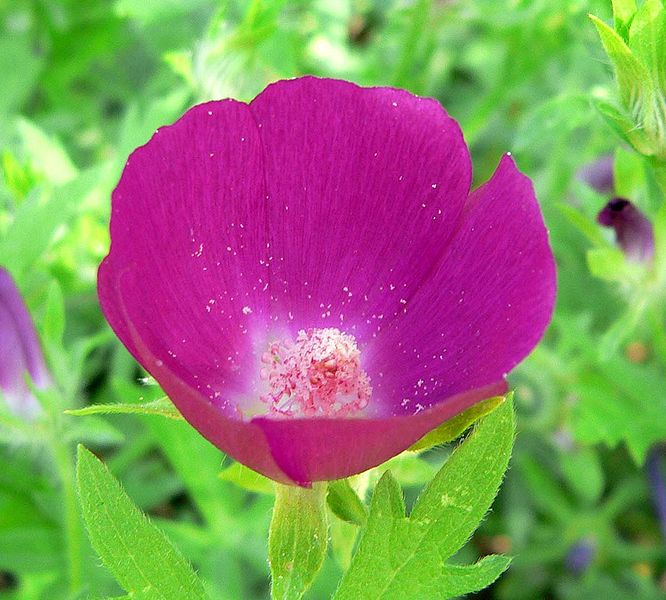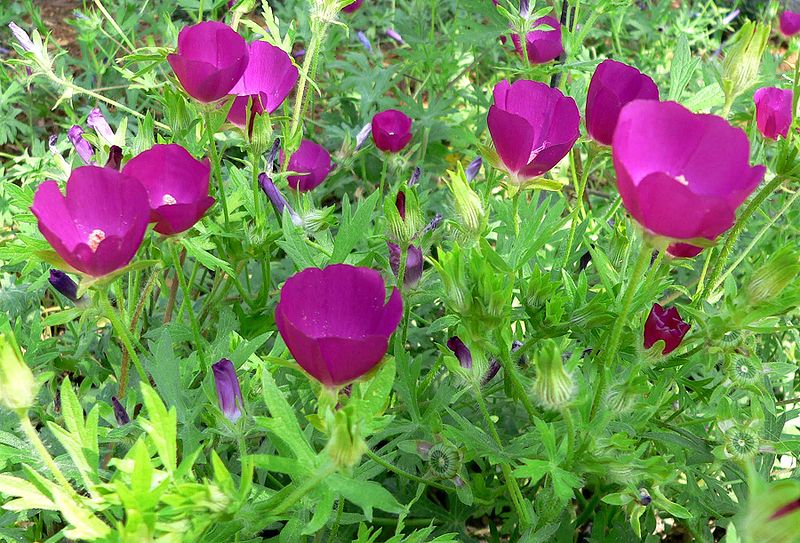 |
|
http://commons.wikimedia.org/wiki/User:Stan_Shebs |
 |
| http://commons.wikimedia.org/wiki/User:Stan_Shebs |
Translate this page:
Summary
Bloom Color: Purple.
Main Bloom Time: Early summer, Late spring. Form: Spreading or horizontal.
Physical Characteristics

 Callirhoe Involucrata is a PERENNIAL growing to 0.2 m (0ft 8in) by 0.5 m (1ft 8in) at a medium rate.
Callirhoe Involucrata is a PERENNIAL growing to 0.2 m (0ft 8in) by 0.5 m (1ft 8in) at a medium rate.
See above for USDA hardiness. It is hardy to UK zone 5 and is not frost tender. It is in flower from July to August, and the seeds ripen from August to September. The species is hermaphrodite (has both male and female organs).
Suitable for: light (sandy) soils, prefers well-drained soil and can grow in nutritionally poor soil. Suitable pH: mildly acid, neutral and basic (mildly alkaline) soils. It cannot grow in the shade. It prefers dry or moist soil and can tolerate drought.
UK Hardiness Map
US Hardiness Map
Synonyms
C. lineariloba. Malva involucrata.
Plant Habitats
Cultivated Beds;
Edible Uses
Edible Parts: Leaves Root
Edible Uses:
Root - cooked[2, 105, 161, 177]. The root is long and tapering[2], it is sweet and starchy with a pleasant taste somewhat like that of a sweet potato[183]. Leaves - cooked. A pleasant flavour with a mucilaginous texture, they are good for thickening soups[183].
References More on Edible Uses
Medicinal Uses
Plants For A Future can not take any responsibility for any adverse effects from the use of plants. Always seek advice from a professional before using a plant medicinally.
Anodyne
A decoction of the root is used to treat internal pain[61, 222, 257]. The root was also dried, then burnt and the smoke either inhaled or allowed to bathe the affected part of the body[222, 257].
References More on Medicinal Uses
The Bookshop: Edible Plant Books
Our Latest books on Perennial Plants For Food Forests and Permaculture Gardens in paperback or digital formats.

Edible Tropical Plants
Food Forest Plants for Hotter Conditions: 250+ Plants For Tropical Food Forests & Permaculture Gardens.
More

Edible Temperate Plants
Plants for Your Food Forest: 500 Plants for Temperate Food Forests & Permaculture Gardens.
More

More Books
PFAF have eight books available in paperback and digital formats. Browse the shop for more information.
Shop Now
Other Uses
References More on Other Uses
Cultivation details
Landscape Uses:
Border, Ground cover, Rock garden. Prefers a light rich sandy loam and a sunny position[1, 200]. Likes a hot dry position[200], growing well on a dry sunny bank[260]. This species is hardy to about -15°c[200]. A deep-rooting plant[235], it strongly resents root disturbance and should be planted into its final position as soon as possible[138]. Slugs are strongly attracted to this plant and can destroy even established plants by eating out all the young shoots in spring[K]. Special Features:
North American native, Naturalizing, Extended bloom season in Zones 9A and above. The plant is heat tolerant in zones 7 through 1. (Plant Hardiness Zones show how well plants withstand cold winter temperatures.
Plant Heat Zones show when plants would start suffering from the heat.
The Plant Heat Zone map is based on the number of "heat days" experienced in a given area where the temperature climbs to over 86 degrees F (30°C).
At this temperature, many plants begin to suffer physiological damage. Heat Zones range from 1 (no heat days) to 12 (210 or more heat days).
For example Heat Zone. 11-1 indicates that the plant is heat tolerant in zones 11 through 1.) For polyculture design as well as the above-ground architecture (form - tree, shrub etc. and size shown above) information on the habit and root pattern is also useful and given here if available. The plant growth habit is a clumper with limited spread [1-2]. The root pattern is a tap root similar to a carrot going directly down [1-2].
References Carbon Farming Information and Carbon Sequestration Information
Temperature Converter
Type a value in the Celsius field to convert the value to Fahrenheit:
Fahrenheit:
The PFAF Bookshop
Plants For A Future have a number of books available in paperback and digital form. Book titles include Edible Plants, Edible Perennials, Edible Trees,Edible Shrubs, Woodland Gardening, and Temperate Food Forest Plants. Our new book is Food Forest Plants For Hotter Conditions (Tropical and Sub-Tropical).
Shop Now
Plant Propagation
Seed - sow outdoors or in a cold frame. Plants resent root disturbance so the seed is best sown in situ in April[138], though the slugs will have a field day if you do not protect the plants[K]. If seed is in short supply then sow it in pots in a cold frame, putting a few seeds in each pot, and plant the pots out in early summer once the plants have put on at least 15cm of growth. Germination usually takes place within 1 - 6 months at 15°c[138]. Cuttings of young basal shoots in a frame in sand[1, 200]. Harvest the shoots when they are about 10cm long with plenty of underground stem. Pot them up into individual pots and keep them in light shade in a cold frame or greenhouse until they are rooting well. Plant them out in the summer. Division[200]. With care since the plant resents root disturbance. We have found that it is best not to disturb this plant and so do not try to divide it, relying instead on taking basal cuttings since these do not disturb the main clump[K].
Other Names
If available other names are mentioned here
Low poppy mallow, Prairie poppy mallow, Purple poppy mallow, Wine cups.
Native Range
NORTHERN AMERICA: United States, Kansas, Missouri, Nebraska, North Dakota, Oklahoma, South Dakota, Colorado (east), Wyoming (Johnson & Goshen Cos.), Arkansas, New Mexico (northeast), Texas, Mexico, Coahuila de Zaragoza, Nuevo León,
Weed Potential
Right plant wrong place. We are currently updating this section.
Please note that a plant may be invasive in one area but may not in your area so it's worth checking.
This plant can be weedy or invasive. Some evidence in Nebraska, USA.
Conservation Status
IUCN Red List of Threatened Plants Status : This taxon has not yet been assessed.

Growth: S = slow M = medium F = fast. Soil: L = light (sandy) M = medium H = heavy (clay). pH: A = acid N = neutral B = basic (alkaline). Shade: F = full shade S = semi-shade N = no shade. Moisture: D = dry M = Moist We = wet Wa = water.
Now available:
Food Forest Plants for Mediterranean Conditions
350+ Perennial Plants For Mediterranean and Drier Food Forests and Permaculture Gardens.
[Paperback and eBook]
This is the third in Plants For A Future's series of plant guides for food forests tailored to
specific climate zones. Following volumes on temperate and tropical ecosystems, this book focuses
on species suited to Mediterranean conditions—regions with hot, dry summers and cool, wet winters,
often facing the added challenge of climate change.
Read More
Expert comment
Author
(Torr.&A.Gray.)A.Gray.
Botanical References
43200235
Links / References
For a list of references used on this page please go here
Readers comment
© 2010, Plants For A Future. Plants For A Future is a charitable company limited by guarantee, registered in England and Wales. Charity No. 1057719, Company No. 3204567.